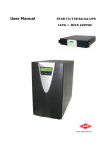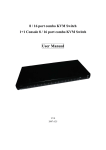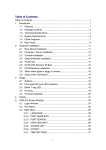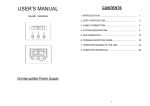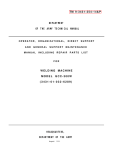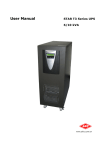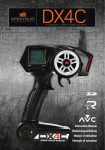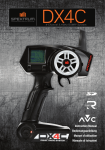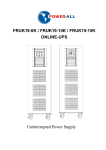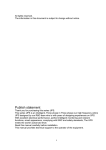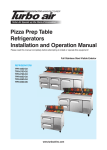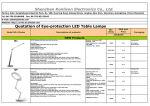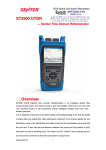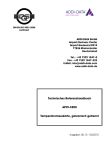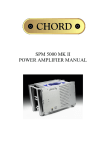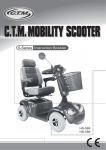Download User Manual - SPM GROUP (LANS)
Transcript
User Manual 1kVA ~ 3kVA 220VAC User Manual 1-3kVA Rev. 9 Contents 1.1 General Description .............................................................................................. 1 1.2 System Configuration........................................................................................... 2 ` Tower .................................................................................................... ……… 2 ` Rack-Mount .................................................................................................... 3 1.3 Front Panel ......................................................................................................... 4 1.3.1 Tower .......................................................................................................... 4 LCD .................................................................................... 4 ` ` LED ..................................................................................... 4 1.3.2 Rack-Mount .................................................................................................. 5 1.4 Rear Panel.......................................................................................................... 6 ` Tower ............................................................................................................ 6 ` Rack-Mount .................................................................................................... 7 ` External Battery Bank or Module ....................................................................... 8 2. Installation............................................................................................................. 9 2.1 Unpacking .......................................................................................................... 9 2.2 Installation ....................................................................................................... 11 ` Tower .......................................................................................................... 11 ` Rack-Mount .................................................................................................. 11 2.3 Connection to communication ............................................................................. 12 2.3.1 Standard.................................................................................................... 12 ` RS-232............................................................................... 12 2.3.2 Optional Interface Cards............................................................................... 13 ` USB Card ............................................................................ 13 ` DB9 Dry Contact Card .............................................................. 13 ` AS400 Card ......................................................................... 14 ` SNMP/HTTP Agent .................................................................. 14 3. Operation ............................................................................................................. 15 3.1 LCD and LED Display.......................................................................................... 15 ` LCD ............................................................................................................ 15 ` LED............................................................................................................. 17 3.2 Starting up/ Shutting down the UPS ..................................................................... 18 3.3 Operating Modes ............................................................................................... 19 3.4 Configuration Settings........................................................................................ 21 ` Output Voltage / Frequency ............................................................................ 21 ` Bypass Voltage ............................................................................................. 22 4. Maintenance ......................................................................................................... 23 4.1 General Maintenance ......................................................................................... 23 ` Environment................................................................................................. 23 ` Storing the UPS and Battery ........................................................................... 23 ` Replace the Battery ....................................................................................... 23 4.2 Replacing the New Battery .................................................................................. 24 4.3 Testing the New Battery ..................................................................................... 24 4.4 Recycling the Used Battery ................................................................................. 24 5. Troubleshooting ................................................................................................... 25 ` ` LCD ............................................................................................. 25 LED ............................................................................................. 27 6. Appendix .............................................................................................................. 28 6.1 Specifications.................................................................................................... 28 ` General Specification ........................................................................................ 28 ` Battery Run Time ............................................................................................. 29 6.2 Contact Information........................................................................................... 30 i User Manual 1-3kVA Rev. 9 Important Safety Instructions SAVE THESE INSTRUCTIONS. This UPS unit operates from utility power and contains a number of high current back-up batteries, the information is important to all personnel involved. Please read this manual before installation and operation of the UPS. Safety of Persons Î Opening or removing the cover of the unit may expose you to lethal voltage within the unit, even if it is apparently not in operation and the input wiring is disconnected from the electrical source. Î Refer all UPS and battery servicing to authorized service personnel from the manufacturer or an agent authorized by the manufacturer. Î Do not dispose of the battery in a fire, as the battery may explode. Î Do not open or damage the battery. Battery acid is toxic and harmful to eyes and skin. Î The following precautions should be observed when working on batteries: • Remove watches, rings, and other metal objects. • Use tools with insulated handles. Product Safety Î Install the UPS in a clean environment, free from moisture, flammable gases or fumes and corrective substances. Î Keep the UPS on a flat, stable surface with a 10cm space around it for proper ventilation. Î Operate the UPS in an indoor environment only in an ambient temperature range of 32oF to +104oF (0oC to +40oC). Î The UPS is designed for data processing equipment. It is not intended for use with life support and other designated “critical” devices. Î The maximum load must not exceed that shown on the UPS rating label. Î Storing magnetic media on top of the UPS may result in data loss or corruption. Î Once batteries have reached the end of their life, ensure they are disposed of properly. REFER TO YOUR LOCAL LAWS AND REGULATIONS FOR BATTERY DISPOSAL REQUIREMENTS. Î The UPS must be handled with care and attention since there is high energy stored within the batteries. It must always be kept in the position marked on the external packaging and must not be dropped. Î Please keep the exhaust holes of UPS unobstructed. Î The battery should be maintained at regular intervals. Special Precautions Î The UPS should be installed according to the instructions in this manual. Failure to do so could result in safety issues. It could also invalidate your warranty. Î DO NOT CONNECT equipment that could overload the UPS or demand half-wave rectification from the UPS, for example: electric drills, vacuum cleaners, printers or hair dryers. Î Adjust only those controls that are listed in the Adjustment Section. If the unit does not operate normally by following the operating instructions, contact the sales representatives. Icon Usage These icons may be found in the contents. WARNING: Obvious danger to personnel or equipment. CAUTION: Possible danger to personnel or equipment Important information ii User Manual 1-3kVA Rev. 9 1. Presentation 1.1 General Description The continuity of electrical power is an essential requirement for critical load operations .The Uninterruptible Power System (UPS) is a compact and quiet solution for power protection of computer, server and office equipment. To choose the UPS as your equipment protector is a wise investment as it supplies reliable, pure and stable power at an affordable price. Feature & Benefits: 9 True on-line double conversion 9 PWM technologies w/ IGBTs 9 Wide input voltage range 9 DC Start 9 Battery self-test 9 Microprocessor based control 9 User-friendly LCD or LED 9 Communication ports: Standard RS232 and optional communication slot for either DB9, USB, AS-400 or SNMP/HTTP card. 9 Light weight unit 9 Optional external battery slot for long runtime requirement Application: 9 Computers 9 Network Servers 9 Workstations 9 Wireless Communication 9 Other Electronic Peripherals - Page 1 of Total 30 - User Manual 1-3kVA Rev. 9 1. Presentation 1.2 System Configuration ` Tower 1kVA: 160W x 220H x 400D mm / 15 kgs 2kVA: 200W x 352H x 450D mm / 34 kgs 3kVA: 200W x 352H x 450D mm / 35 kgs - Page 2 of Total 30 - User Manual 1-3kVA Rev. 9 1. Presentation ` Rack-Mount 1kVA: 440W x 88H x 465D mm / 15.5 kgs 2kVA: 440W x 88H x 465D mm / 35 kgs 3kVA: 440W x 88H x 465D mm / 36 kgs - Page 3 of Total 30 - User Manual 1-3kVA Rev. 9 1. Presentation 1.3 Front Panel 1.3.1 Tower ` LCD 1234 5 6 7 1. 2-line LCD Display 2. Normal LED (green) 3. Warning LED (yellow) 4. Fault LED (red) 5. Select-up button 6. Select-down button 7. Enter button 5-6. Off button 6-7. On button 5-7. Test/Silence button ` LED 1 2 34 56 1. Line LED (green) 2. Load & Battery Capacity LEDs 3. Battery LED (yellow) 4. Bypass LED (yellow) 5. Fault LED (red) 6. Inverter LED (green) 7. Select-up button 8. Select-down button 9. Enter button 7-8. Off button 8-9. On button & Test/Silence button - Page 4 of Total 30 - 7 8 9 User Manual 1-3kVA Rev. 9 1. Presentation 1.3.2 Rack-Mount 1234 1. 2-line LCD Display 2. Normal LED (green) 3. Warning LED (yellow) 4. Fault LED (red) 5. Select-up button 6. Select-down button 7. Enter button 5-6. Off button 6-7. On button 5-7. Test/Silence button - Page 5 of Total 30 - 5 6 7 User Manual 1-3kVA Rev. 9 1. Presentation 1.4 Rear Panel ` Tower 1 ○ 1 ○ 6 ○ 2 ○ 8 ○ 7 ○ 2 ○ 6 ○ 7 ○ 1 ○ 2 ○ 6 ○ 7 ○ 8 ○ 9 ○ 9 ○ 8 ○ 9 ○ 10 ○ 3 ○ 4 ○ 4 ○ 4 ○ 5 ○ 5 ○ 1kVA 5 ○ 3 ○ 2kVA 1. Standard RS232 Port 2. Fan 3. External Battery Slot (Option) 4. Input Breaker 5. Inlet 6. Communication ports: DB9, USB, AS400, SNMP/HTTP (Option) 7. Surge Protection: RJ45 8. LCD Remote Control (Option) 9. Outlets (IEC, German) 10. Outlets (Terminal Block for 3kVA only) - Page 6 of Total 30 - 3 ○ 3kVA User Manual 1-3kVA Rev. 9 1. Presentation ` Rack-Mount 1kVA 1 ○ 2 ○ 3 ○ 7 ○ 4 ○ 5 ○ 8 ○ 6 ○ 9 ○ 2kVA 4 ○ 3 ○ 7 ○ 6 ○ 1 ○ 2 ○ 5 ○ 9 ○ 8 ○ 3/2(long run time)kVA 4 ○ 3 ○ 7 ○ 6 ○ 1 ○ 2 ○ 8 ○ 5 ○ 11 ○ 9 ○ 10 ○ 1. External Battery Slot (Option) 2. Outlets (IEC 10A,Germen) 3. Inlet 4. Input fuse 5. Fan 6. Communication Ports:DB9,USB,AS400,SNMP/HTTP (Option) 7. LCD Remote Control (Option) 8. Surge Protection: RJ 45 9. Standard RS232 Port 10. Output Terminal 11. Output fuse - Page 7 of Total 30 - User Manual 1-3kVA Rev. 9 1. Presentation ` External Battery Bank or Module For Tower Product ranges: For Rack-Mount product ranges: - Page 8 of Total 30 - User Manual 1-3kVA Rev. 9 2. Installation 2.1 Unpacking You may find the “series number” labeled on both shipping box and UPS rear panel. If the UPS has a problem please send the number to your sales representative for tracking and troubleshooting. The ST Series UPS can be supplied in a varied number of boxes depending upon the model ordered. The number of boxes provided should be as follows: BATTERY MODULE (Box 2) N/A (internal batter N/A (internal battery) 1 Battery Module MODEL (Box 1) ST 3200 Tower ST 3200R Rack Mount ST 3200R Rack Mount TOTAL BOXES 1 Box 1 Box 2 Boxes ST Series 1kVA ~ 3kVA Tower Box 1 c d e f Shipping Box Includes: 1. UPS 2. User Manual 3. Input Power Cord (German, British, Australian) 4. Extension Power Cord (IEC) to PC (for output receptacles “IEC” only) - Page 9 of Total 30 - User Manual 1-3kVA Rev. 9 2. Installation ST Series 1-3kVA Rack Mount Box 1 c d e f g Shipping Box Includes: 1. UPS 2. User Manual 3. Input Power Cord (German, British, Australian) 4. Extension Power Cord (IEC) to PC (for output receptacles “IEC” only) 5. 2pcs 19” rack ears (+screws) Box 2 (for 2/3kVA Rack Mount and external battery module) c d e Box 2 Includes: 1. Battery Module 2. 2pcs 19” rack ears (+screws) 3. Battery cable - Page 10 of Total 30 - User Manual 1-3kVA Rev. 9 2. Installation 2.2 Installation ` Tower Optional Communication Slot Standard RS232 to PC RJ45 protection for Tel/Fax/Modem/DSL Remote control AS400 USB To external battery cabinet DB9 To the wall socket Output to the loads SNMP/HTTP ` Rack-Mount To the wall socket Optional Communication Slot Output to the load To external battery cabinet Remote control Standard RS232 to PC RJ45 protection for Tel/Fax/Modem/DSL Keep the UPS on a flat, stable surface with a 10cm space around it for proper ventilation. - Page 11 of Total 30 - User Manual 1-3kVA Rev. 9 2. Installation 2.3 Connection to communication 2.3.1 Standard ` RS-232 The communication interface (DB9 port) on the back of the UPS may be connected to a host computer with specific monitoring software installed. (Please contact a sales representative for further information of monitor software) The pins of the connector are as following: PIN # 2 3 5 PIN Definition (UPS) Transmitted data Received data Signal Ground PIN Definition (PC) Received data Transmitted data Signal Ground The RS-232 interface settings are as follows: Baud Rate Data Length Stop Bit Parity - Page 12 of Total 30 - 2400 bps 8 bits 1 bit None User Manual 1-3kVA Rev. 9 2. Installation 2.3.2 Optional Interface Cards A variety of interface cards can be installed into optional communication slot such as DB9 Dry Contact Card, USB Card, AS400 Card, and SNMP/HTTP Card. ` USB Card ` DB9 Dry Contact Card Pin Definition of DB9 for NOVELL Interface PIN # of DB9 Function explanation 1 UPS Fault 3 GND 4 I/O Output Input Remote Shutdown UPS(+12VDC)(work on Battery Mode) Input 5 Input 12VDC Input 6 Bypass Mode Output 7 Low Battery Output 8 Normal Mode, Battery Mode Output 9 Utility Power Fault Output - Page 13 of Total 30 - User Manual 1-3kVA Rev. 9 2. Installation ` AS400 Card ` SNMP/HTTP Agent NetAgent Mini allows a user to obtain the status, and issue commands to the UPS. The communications protocol includes the MegaTec/ PPC/ SEC 2400 / 9600. Also it is possible to build in your own protocol. NetAgent Mini provides a simple and easy installation procedure. The user only needs to install the software from the NetAgent Mini CD on a Windows environment and configure the IP address. All the other configurations could be accomplished in a Web browser. NetAgent Mini also provides shutdown programs for different operating systems. Shutdown commands can be sent for such events as power failure, low UPS battery condition, UPS overload, UPS overheating and scheduled shutdowns. All shutdown events are configurable by the user. The shutdown software provides an orderly shutdown to prevent the abnormal shut-off of clients or servers. Please refer to the NetAgent Mini installation CD for more information. - Page 14 of Total 30 - User Manual 1-3kVA Rev. 9 3. Operation 3.1 LCD and LED Display ` LCD “Select-Down” Key: y y “Select-Up” Key: The welcome screen only shows for 10 seconds as UPS starts up, after that the “UPS Status” will show on the display. The screen should go back to “UPS Status” if you do not push any buttons for 2 minutes. Display 1 - Welcome screen Display 2 - Input/Output Voltage and Frequency Identification Display 3 – UPS Status AEC Star T3 Series On-Line UPS Input:220V 50Hz Output:220V 50Hz AC:FAIL BATT:LOW NO Output Display 4 – Real Input/Output Voltage and Frequency Input Voltage 220 VAC Output Voltage 220VAC Input Frequency 50 Hz Output Frequency 50 Hz - Page 15 of Total 30 - User Manual 1-3kVA Rev. 9 3. Operation Display 5 – Battery Voltage/ Capacity Battery Voltage 37 VDC Battery Capacity 100 % Display 6 – Output Power Output Power 100 % Display 7 – Inside Temperature Display 8 – New Alarm Inside TEMP 33 ℃ 91 ℉ NEW AC Fail: 1 ALM Overload: 3 Display 9 – Old Alarm OLD AC Fail: 5 ALM Overload: 9 Display 10 – Bypass Voltage Setting Display 11 – Output Voltage/ Frequency Setting Bypass Volt Set LO= 176V HI=253V Volt/Freq Set 220 VAC 50 Hz - Page 16 of Total 30 - User Manual 1-3kVA Rev. 9 3. Operation ` LED 1 6 7 8 9 10 2 3 4 5 1. Line LED (green): This indicates the AC power is applied to the UPS input. If the LED blinks, it means the AC power source is out of tolerance. 2. Battery LED (yellow): This indicates the UPS is in Battery Mode. 3. Bypass LED (yellow): This indicates the UPS is in Bypass Mode. 4. Fault LED (red): This indicates the UPS is in fault condition because of UPS shutdown or over-temperature 5. Inverter LED (green): This indicates the inverter is working normally. 6-10. Load & Battery Capacity LEDs: (a) No. 6 to 7 LED is green color, No. 8 to 9 is yellow and No.10 (used as warning LED for overload or battery low) is red. (b) These LEDs show the load (%) of the UPS if the AC input is available (in Normal Mode). LEDs light up to indicate the following information. No. 6 LED: 0-25 % No. 6 - 9 LEDs: 76-100 % No. 6 - 7 LEDs: 26-50 % No. 6 - 10 LEDs: Overload No. 6 - 8 LEDs: 51-75 % (c) In the Battery Mode, the LEDs indicate the capacity (%) of the batteries. LEDs light up to indicate the following information. No. 10 LED: 0-25 % (battery low level) No. 9 - 10 LEDs: 26-50 % No. 7 - 10 LEDs: 76-95 % No. 8 - 10 LEDs: 51-75 % No. 6 - 10 LEDs: 96-100 % - Page 17 of Total 30 - User Manual 1-3kVA Rev. 9 3. Operation 3.2 Starting up/ Shutting down the UPS Starting up the UPS Step 1. Plug the UPS into an AC wall socket and the UPS will enter Bypass mode. Step 2. Press the “Select-down” & “Enter” button simultaneously to switch on UPS. The UPS will begin its start-up process. After entering the Normal Mode, the UPS is ready for operation. Shutting down the UPS Press the “Select-up” & “Select –down” button simultaneously for one second. turn off. The UPS will During shutdown, do not press any buttons. Pressing a button may cause the UPS to re-energize and deliver output power. DC Start-up of the UPS Step 1: Without connecting the UPS into any AC input power. Step 2: Press the “Select-down” & “Enter” button simultaneously to switch on UPS. The UPS will begin its start-up process. After entering the Battery Mode, the UPS is ready for operation. - Page 18 of Total 30 - User Manual 1-3kVA Rev. 9 3. Operation 3.3 Operating Modes Normal Mode There are two main circuits when AC utility is normal: the AC circuit and the battery charging circuit. The AC output power comes from AC utility input and passes through AC/DC rectifier, DC/AC inverter and static switch to support power to load. The battery charging voltage comes from AC utility input and is converted by AC/DC charger to support battery-charging power. Battery Mode The AC output comes from battery, passing through DC/AC inverter and static switch within the battery backup time. - Page 19 of Total 30 - User Manual 1-3kVA Rev. 9 3. Operation Bypass Mode Under the following conditions, the bypass will be enabled: 1. Overload. 2. Inverter failure. 3. Over-temperature - Page 20 of Total 30 - User Manual 1-3kVA Rev. 9 3. Operation 3.4 Configuration Settings UPS must be working on Bypass Mode in advance for any setting, because the setting function can not be available on Normal Mode and Battery Mode. ` Output Voltage / Frequency Step 1. In this screen, press the “Enter” key to proceed to the following steps for output voltage / frequency adjustment. Display 11 – Output Voltage/ Frequency Setting Volt/Freq Set 220 VAC 50 Hz Step 2. The cursor (→) will pop up to indicate the output voltage and frequency newly selected. Display 11 – Output Voltage/ Frequency Setting Display 11 – Output Voltage/ Frequency Setting Volt/Freq Set 220 VAC 50 Hz Volt/Freq Set 220 VAC 50 Hz Step 3. Use “Select-Up” or “Select-Down” keys to adjust the output voltage (220V, 230V, and 240V ). Press the “Enter” key to confirm voltage and then the cursor will move to frequency selection. The output frequency (50Hz, 50HzP, 60Hz, 60HzP) can be adjusted by the same key operation. Step 4. Once the correct voltage is selected, press the “Enter” key again to save the selection. There is no output on Bypass Mode if frequency is setting on 50Hz/60Hz, on the other hand, there is output on Bypass Mode if frequency is setting on 50HzP/60HzP. Display 11 – Output Voltage/ Frequency Setting Volt/Freq Set Save? NO - Page 21 of Total 30 - User Manual 1-3kVA Rev. 9 3. Operation ` Bypass Voltage UPS must be working on Bypass Mode in advance for any setting, because the setting function can not be available on Normal Mode and Battery Mode. Step 1. To protect the load, the function of bypass auto-transfer is activated only when the AC main voltage is within the range of LO (low) and HI (high). In this screen, press the “Enter” key to enter the following steps for LO/HI voltage settings. Display 10 – Bypass Voltage Setting Bypass Volt Set LO= 176V HI=253V Step 2. The cursor (→) will pop up to indicate the item newly selected. Press the “Enter” key to select the item (either HI or LO range) you wish to adjust. Display 10 – Bypass Voltage Setting Bypass Volt Set LO= 176V HI=253V Display 10 – Bypass Voltage Setting Bypass Volt Set LO= 176V HI=253V Step 3. Use the “Select-Up” or “Select-Down” keys to adjust the voltage (changing 1V by every press). LO (low rang):176V+/- 20V, HI (high range):253V+/- 20V). Step 4. Once the value is confirmed, press the “Enter” key again to save the data. Display 10 – Bypass Voltage Setting Bypass Volt Set Save? NO - Page 22 of Total 30 - User Manual 1-3kVA Rev. 9 4. Maintenance 4.1 General Maintenance The ST Series UPS requires only very simple maintenance. The batteries are sealed, valve-regulated, maintenance-free and enclosed in a fire-retardant pack. The batteries should be kept charged to maintain their designed lifetime. When utility power is supplied to the UPS, it will continuously charge the batteries. ` Environment Î For the best preventive maintenance, keep the area around the UPS clean and dust-free. Î Please keep the exhaust holes of UPS unobstructed. Î Operate the UPS in an indoor environment with an ambient temperature range of 32°F to +104°F (0°C to +40°C). Î Keep the UPS on a flat, stable surface with a 10cm space around it for proper ventilation. Î Do not place the unit near a heat source also avoid placing the unit in direct sunlight. Î Do not place the unit near water or excessive moisture. ` Storing the UPS and Battery When storing the UPS for any length of time, it is recommended to plug in the UPS for at least 24 hours every four to six months to ensure full battery recharge. ` Replace the Battery It is suggested that the battery pack be replaced every two years to ensure that the UPS provides full backup capacity during a blackout. Batteries should be checked every two to three months. If the batteries need replacing, please contact your sales representative to order a new battery. - Page 23 of Total 30 - User Manual 1-3kVA Rev. 9 4. Maintenance 4.2 Replacing the New Battery This UPS contains potentially hazardous voltages. Do not open the UPS. user-serviceable parts inside. Î Î Î Î Î Î Î Î There are no When replacing the battery, use the same number and voltage(V) /capacity(Ah). Avoid harm to the environment: proper disposal or recycling of the batteries is required. Refer to local regulations for disposal requirements. NEVER dispose of the battery in a fire. They may explode. Do not open or damage the battery. The contents (electrolyte) may be extremely toxic. If exposed to electrolyte, then wash immediately with plenty of water. Avoid charging in a sealed container. Never short circuit the battery. When working with batteries, remove watches, rings and other metal objects. Only use insulated tools. The following precautions should be observed when working on batteries: • Remove watches, rings, and other metal objects. • Use tools with insulated handles. Make sure that there is no voltage before touching the batteries. 4.3 Testing the New Battery Start up the UPS with load added. Press the “Select-up” & “Enter” buttons for three seconds to activate the self-test. If the UPS switches back to Normal Mode after 10 seconds, then the batteries are good. If it does not, then please replace the battery or contact your sales representative for assistance. 4.4 Recycling the Used Battery Do not discard the UPS and batteries with normal household/industrial waste. Contact your local recycling or hazardous waste center for information on proper disposal of used battery pack and batteries. Consider all warnings, cautions, and notes before replacing batteries. Batteries can present a risk of electrical shock and high short circuit current. The following precautions should be observed when working on batteries: Î Remove watches, rings, and other metal objects. Î Use tools with insulated handles. Î Do not lay tools or metal parts on top of batteries. Î Do not attempt to alter any battery wiring or connectors. Attempting to alter wiring can cause injury. Î Do not dispose of batteries in a fire. The batteries may explode. Refer to your local codes for disposal requirements. Î Do not open or damage the battery or batteries. Released electrolyte is harmful to the skin and eyes and it is toxic. - Page 24 of Total 30 - User Manual 1-3kVA Rev. 9 5. Troubleshooting LCD ` LCD & LED Status / Audible Alarms AC: OK BATT: OK TEMP Fail Fault Warning Normal y y y y y y Possible Cause 1. Fan fail. 2. Temperature is higher than allowed operation temperature. UPS in Bypass Mode. The alarm beeps continuously. AC: OK BATT: OK Inverter Fail Fault Warning Normal 1. UPS in Bypass Mode. Fault LED lights up and the alarm beeps continuously. AC: OK BATT: OK DC_BUS Fail Fault Warning Normal 1. UPS stop working. The alarm beeps continuously. AC: OK BATT: LOW Normal Mode Fault Warning Normal UPS in Normal Mode, but battery capacity is low. y The alarm beeps once every second for battery low. Output Power 105 % Fault Warning Normal 2. Inverter circuit failed Output short. Action 1. 2. Replace the fan. Reduce ambient temperature or O/P load. 1. Please contact with sale representative. 2. Remove short circuit condition, restart the UPS. Power Board failed. 1. Restart the UPS first. If the UPS can not work normally, please contact with sale representative. 1. Charger may break down. 1. Please replace charger board. 1. 1. Please reduce the load less than 100%. y y y AC utility power is normal but UPS is overloaded. Warning LED lights up and the alarm beeps per 1 second. - Page 25 of Total 30 - Overload. User Manual 1-3kVA Rev. 9 5. Troubleshooting Fault LCD & LED Status / Audible Alarms Output Power 125 % Warning Normal AC utility power is normal but UPS is overloaded up to 125%. y Warning LED does not fade out and alarm beeps per 0.5 second. AC: OK BATT: OK Bypass Mode Fault Warning Normal Possible Cause Action 1. Overload. 1. Please reduce the load less than 100%. 1. Overload. 1. Please reduce the load less than 100%. 1. AC utility power fail Input cable broken or disconnect with UPS. 1. AC utility power fail. Battery power is discharging deeply. 1. UPS will shut down automatically. Please save data soon. AC utility power fail. The UPS has already run out of battery. 1. UPS will restart up when AC utility power is restored. If AC utility power failure is more than 6 hours, please charge the battery for 24 hours to ensure the battery fully charged. y UPS in Bypass Mode. Output power is more than 150%. y Warning LED lights up and alarm beeps continuously. AC: Fail BATT: OK Battery Mode Fault Warning Normal y y y y y UPS in Battery Mode. Alarm beeps every 4 seconds. AC: Fail BATT: LOW Battery Mode Fault Warning Norma 2. 1. 2. UPS in Battery Mode. The alarm beeps per 1 second. 1. Fault y 2. If AC utility power fails, reduce the load in order to extend backup time. If it is not power failure, please check the rated input or connected power line. Warning Norma 2. UPS completely shut down. - Page 26 of Total 30 - User Manual 1-3kVA Rev. 9 5. Troubleshooting LED ` y y y y y y y y y y y y y LED Status / Audible Alarms No indication and buzzer alarm even though system is connected to mains power supply. Line LED flash. Line LED flash and Battery LED illuminate. Line and Bypass LED illuminated even though the power supply is available. Inverter LED illuminated. Alarm sounds every 4 second. Fault LED illuminated. Buzzer alarm sounds per every 1 second. Fault LED illuminated. Buzzer alarm sounds continuously. UPS completely shut down. Fault and Battery LED illuminated. The alarm sounds per every 1 second Possible Cause Action 1. No input voltage 1. Check building wiring socket outlet and input cable. 1. Phase and neutral conductor at input of UPS system are reversed. 1. Input voltage/frequency are out of tolerance 1. 1. Rotate main power socket by 180 to connect UPS system. Check input power source. 1. UPS not turn on. 1. Please turn on the UPS 1. AC utility power fail. 1. UPS go to battery mode automatically. 2. As the audible alarms per every 1 second, battery is almost empty. 1. Please reduce the load less than 100%. 1. Overload. 1. UPS Fault 1. Please contact with sale representative. 1. 2. AC utility power fail. The UPS has already run out of battery. 1. 1. Charger or Battery may break down. 1. UPS will restart up when AC utility power is restored. If AC utility power failure is more than 6 hours, please charge the battery for 24 hours to ensure the battery fully charged. Please contact with sale representative. - Page 27 of Total 30 - User Manual 1-3kVA Rev. 9 6. Appendix 6.1 Specifications ` General Specification Specifications ST3200 (tower) ST3200R (rack-mount) Model No. Topology ST3200 (tower) ST3200R (rack-mount) ST3200 (tower) ST3200R (rack-mount) True On - Line , Double Conversion On- battery Output Waveform Pure Sine Wave Number of Phase Single ( 1 Φ 2W + G ) Input Maximum Capacity ( VA / W ) 1000 VA / 700 W 2000 VA / 1400 W Nominal Input Voltage 3000 VA / 2100 W 230 VAC Input Voltage Regulation 160~300 VAC Single Phase w/ Ground Nominal Input Frequency 50/60 ± 4 Hz Input PFC ≧ 0.95 Input Short Protection Circuit Breaker Output Nominal Output Voltage 220 / 230 / 240 VAC nominal Output Voltage Regulation +/-2% Output T.H.D ≦3% ( Linear Load) ≦4% THD ( Linear Load) ≦6% ( Non-Linear Load) ≦7% THD ( Non-Linear Load) High Efficiency Mode ( AC to AC ) 85% 85% 88% High Efficiency Mode ( DC to AC ) 83% 83% 83% Crest Factor 3:1 Start on Battery Yes Output Frequency 50 Hz + / - 0.2 Hz Overload Sustaining 30 sec @ 125%~150% load; 200ms @ >150% load Battery Typical Backup Time ( Full load ) Battery Type 5 minutes 9 minutes 5 minutes Sealed Lead-Acid maintenance-free 12VDC/7AH per cell Numbers of Batteries 3 cells 8 cells Recharge Time to 90% 5 hours Advance Warning Diagnostics UPS Status, I/P Voltage & Frequency, O/P Voltage & Frequency, Battery Voltage, Battery Capacity, Loading %, Temperature, History Alarm. Normal ( Green ), Warning ( Yellow ), Fault ( Red ) Front Panel Indication - LCD Front Panel Indication - LED Audible Alarms Battery Mode, Communication Interface Communication port SNMP Manageable Low Battery, Overload, Fault RS232 (Standard); DB9 or USB or AS400 or SNMP / HTTP(Optional) Yes Environmental Operation Temperature 0-40℃ Storage Temperature - 15 to 50 ℃ Relative Humidity 20% to 90 % Non-Condensing Audible Noise ( at 1 meter from surface of unit ) Mechanical Tower Dimensions ( W x H x D mm ) < 45 dBA @ 1 meter 160 x 220 x 400 Rack-mount Dimensions ( W x H x D mm ) 440 x 88 x 465 ( w/ internal battery ) Tower Weight ( Net weight with Battery ) ( kgs ) Rack Mount Weight ( Net weight with Battery ) ( kgs ) < 50 dBA @ 1 meter 200 x 352 x 450 200 x 352 x 450 440 x 88 x 465 ( UPS only ) 440 x 88 x 465 ( External Battery Module ) 15 34 35 15.5 35 36 - Page 28 of Total 30 - User Manual 1-3kVA Rev. 9 6. Appendix ` Battery Run Time Tower RUN TIME CHART in Minutes Output load 200 VA 400 VA 600 VA 800 VA 1000 VA 1500 VA 2000 VA 2500 VA 3000 VA (140 W) (280 W) (420W) (560W) (700 W) (1050 W) (1400 W) (1750 W) (2100 W) UPS Model ST3010 60 24 13 8 5 + 1 EB (6pcs) 243 102 61 42 30 + 2 EB (12pcs) 451 194 117 81 61 + 3 EB (18pcs) 675 293 178 124 94 ST3020 210 88 52 36 26 15 9 + 1 EB (8pcs) 488 210 127 88 66 39 26 + 2 EB (16pcs) 791 345 210 147 111 66 45 + 3 EB (24pcs) 1110 488 299 210 159 96 66 ST3030 210 88 52 36 26 15 9 7 5 + 1 EB (8pcs) 488 210 127 88 66 39 26 19 15 + 2 EB (16pcs) 791 345 210 147 111 66 45 34 26 + 3 EB (24pcs) 1110 488 299 210 159 96 66 49 39 Rack Mount RUN TIME CHART in Minutes Output load 200 VA 400 VA 600 VA 800 VA 1000 VA 1500 VA 2000 VA 2500 VA 3000 VA (140 W) (280 W) (420W) (560W) (700 W) (1050 W) (1400 W) (1750 W) (2100 W) UPS Model ST3R10 60 24 13 8 5 345 147 88 61 45 + 2 BM (18pcs) 675 293 178 124 94 + 3 BM (27pcs) 1029 451 276 194 147 ST3R20 210 88 52 36 26 15 9 + 1 BM (8pcs) 488 210 127 88 66 39 26 + 2 BM (16pcs) 791 345 210 147 111 66 45 + 3 BM (24pcs) 1110 488 299 210 159 96 66 ST3R30 210 88 52 36 26 15 9 7 5 + 1 BM (8pcs) 488 210 127 88 66 39 26 19 15 + 2 BM (16pcs) 791 345 210 147 111 66 45 34 26 + 3 BM (24pcs) 1110 488 299 210 159 96 66 49 39 + 1 BM (9pcs) EB: External Battery Bank (for Tower type) BM: External Battery Module (for Rack Mount type) Indicates time not calculated, contact sales representative for details. - Page 29 of Total 30 -
































